April 29: holidays and events on this day

On April 29, All-Ukrainian Football Day, the Day of Remembrance of All Victims of Chemical Weapons Use and the related International Foundation Day of the Organization for the Prohibition of Chemical Weapons, as well as the International Day of Immunology and the International Day of Dance are celebrated. In history, this day is marked by numerous events that left a mark in politics, science, wars and culture.
All-Ukrainian Football Day
This is an unofficial but extremely symbolic holiday, designed to honor the most popular sport in the country. This is not only a tribute to the game of millions, but also an opportunity to remember its history, achievements, social role and people who created and are creating Ukrainian football.
The date of April 29 was chosen because it was on this day in 1992 that the independent Ukrainian football team played its first official match in Kharkiv, then the capital of Ukraine. The opponent of the Ukrainians was the Hungarian national team. Although the match ended in a 1:3 defeat, it marked the beginning of a new page in the country’s sports annals. Since then, the blue-yellow national team has gone through a difficult path — from the uncertainty of the first years to reaching the finals of the World and European championships.
Football in Ukraine is not only competitions and cups. During the war, it turned into a space of unity, support and humanitarian mission. Clubs organize gatherings for the military, hold charity matches, and help displaced people. Some football players have become volunteers, volunteers or ambassadors of Ukraine in the world. The game has become a part of resistance and national dignity, and football fields have become places of psychological recovery for children who have survived the horrors of war.
Special attention is paid in Ukraine to the development of children’s, youth and amateur football. It is on the local fields, where boys and girls chase the ball after school, that the future of Ukrainian sports is being formed. Thanks to the initiatives of local communities, enthusiastic coaches and support from the UAF, new talents appear every year, which then join professional sports.
All-Ukrainian Football Day is also an opportunity to honor veterans — those who glorified Ukraine in the past. Former players of “Dynamo”, “Shakhtar”, “Dnipro” and other clubs take part in meetings, memory tournaments, master classes for children. This is not just a memory of the past, but a bridge between generations.
Interesting facts
– The most productive player of the national team of Ukraine is Andrii Shevchenko with 48 goals. He became the first Ukrainian to win the Golden Ball in 2004.
The first official match of the Ukrainian national team (April 29, 1992) took place at the “Metalist” stadium in Kharkiv. The author of the first historical goal in the “blue-yellow” team was Ivan Getsko.
The youngest debutant of the national team is Ilya Zabarny, who entered the field at the age of 18.
Ukrainian clubs have repeatedly played in the finals of European Cups. Dynamo Kyiv won the UEFA Cup Winners’ Cup in 1975 and 1986, while Shakhtar Donetsk won the UEFA Cup in 2009.
Football in the frontline zones does not stop even during the war: in some regions, children play football in bomb shelters or in the open air, to the sound of sirens.
In 2022, the U-19 girls’ national team of Ukraine made it to the elite round of the European Championship for the first time in history.
More than 1 million Ukrainians play soccer at the amateur level, and this movement is actively supported both in Ukraine and in Ukrainian communities abroad.
A number of Ukrainian football players joined the Armed Forces or became volunteers during the full-scale war. Among them are Roman Zozulya, Artem Fedetskyi, Serhiy Nagornyak.
The Day of Remembrance for All Victims of the Use of Chemical Weapons and the International Foundation Day of the Organization for the Prohibition of Chemical Weapons (OPCW)
These events are closely related and have a common date of occurrence: it was on this day in 1997 that the Convention on the Prohibition of Chemical Weapons entered into force, which initiated the system of international control over their elimination.
The celebration of these two dates has a dual purpose. First, it is commemoration of all those killed and injured by poisonous substances — both in interstate wars and in local conflicts or acts of terror. There are many tragic examples in history: the First World War, chemical attacks in Syria, sarin poisoning in Tokyo, the use of war toxins in Kurdistan, cases of political poisoning in peaceful European countries. In all of these cases, chemical weapons left lasting physical, mental, and environmental effects.
Secondly, April 29 is the date of the creation of an international mechanism that allows not only to condemn the use of chemical weapons, but also to prevent their occurrence. The Organization for the Prohibition of Chemical Weapons (OPCW), headquartered in The Hague, has become a platform for the cooperation of 193 states. It provides inspections, investigations, victim assistance and technical support to countries at risk of chemical terror. The OPCW monitors more than 4,000 facilities around the world, and also organizes training, responds to violations and publishes reports that become the basis of international decisions.
The Convention on the Prohibition of Chemical Weapons was the result of a century of effort. Its signing was a response to the terrible experience of the First World War, when more than 124 thousand tons of chemical agents were used. In the 21st century, the fight against chemical weapons is not over. It remains an element of political pressure, a violation of humanitarian law and an instrument of terror, in particular in Syria or in the poisoning of opposition parties. That is why the international mechanism created on April 29, 1997 remains relevant.
For Ukraine, this date has a special significance. In the context of a full-scale war with Russia, there have been repeated statements about the risks of using banned toxic substances. Ukraine insists on the need to strengthen control, open investigations and prevent violations of the Convention from being ignored.
Interesting facts
During the First World War, chlorine, phosgene, and mustard gas were used — a total of about 124,000. tons of chemical agents.
The name “mustard” comes from the Belgian city of Ypres, where it was used en masse for the first time.
The USA and Russia had the largest chemical arsenals in the world. The US officially completed their destruction in 2023. Russia announced the destruction in 2017, but the international community questions this.
193 states have joined the Convention on the Prohibition of Chemical Weapons. Only Egypt, Israel, North Korea and South Sudan did not ratify it.
There are at least 38 known cases of chemical weapons use in Syria, according to the OPCW and independent groups.
In 2013, the OPCW received the Nobel Peace Prize for its large-scale work on the elimination of chemical weapons.
The organization has conducted more than 3,800 inspections at chemical facilities in more than 80 countries.
Chemical weapons have been banned since the 1925 Geneva Protocol, but only the 1997 Convention introduced a real verification and sanctions mechanism.
The OPCW has conducted more than 3,800 inspections worldwide, destroying more than 98% of declared chemical weapons stockpiles.
International Day of Immunology
This day is designed to draw attention to one of the most complex and at the same time most important areas of biomedical science. This day was initiated by the European Federation of Immunological Societies (EFIS) in 2005 and today is supported by specialists all over the world, including Ukraine.
Immunology is the science of the immune system: the complex biological mechanism that protects the body against infections, viruses, bacteria, fungi, toxins, and even malignant cells. The immune system does not simply react to foreign objects — it remembers the enemy, differentiates own tissues from foreign ones, forms immune memory, maintains homeostasis and controls inflammatory processes.
In the 21st century, immunology has become key in the fight against pandemics, autoimmune disorders, allergies, oncology, transplantology, and vaccine development. Thanks to her, innovative methods of treatment appeared – from cancer immunotherapy to mRNA vaccines.
The International Day of Immunology has several goals. First, it is education – to explain to the general public how immunity works and what affects its condition. Second, it is the recognition of the role of researchers, doctors and biotechnologists in the creation of vaccines, monoclonal antibodies, test systems and other tools used in clinical practice. Thirdly, it is an emphasis on the importance of funding basic science and applied developments in the field of immunology.
In the conditions of a full-scale war in Ukraine, immunology acquires additional importance. Injuries, infections, stress, constant movement, exposure to radiation and toxins all directly affect the state of the immune system of the population. In military medicine, knowledge of immunological reactions is critical for treating the wounded, avoiding sepsis, and controlling autoimmune reactions after injuries. Specialists are also working on the impact of chronic stress and long-term residence in a war zone on children’s immunity. At the same time, laboratory diagnostics, immunoprophylaxis (in particular, vaccination), as well as academic immunology are developing in Ukraine – despite the war, research continues on the basis of leading medical universities and institutes.
Interesting facts
The term “immunity” comes from the Latin word immunis, which means “released” (from disease or duty).
The immune system has a “memory”: it remembers the pathogen it encountered and reacts to it more quickly upon repeated contact.
Vaccination is one of the most successful forms of immunological intervention. According to WHO estimates, vaccines save up to 5 million lives every year.
Each person has a unique set of receptors on T-lymphocytes – this is a biological imprint, more complex than DNA.
Research on immunity has led to a revolution in oncology: the method of CAR-T therapy allows you to “teach” immune cells to destroy tumors.
The immune system is not a single organ, but a complex network: it includes the bone marrow, spleen, thymus, lymph nodes, tonsils, skin, mucous membranes.
Excessive activity of the immune system leads to autoimmune diseases, such as rheumatoid arthritis, Crohn’s disease, and multiple sclerosis.
A newborn’s immunity is formed gradually, and he receives the first protective antibodies from breast milk.
In 2020-2021, immunology became a leading science in the fight against COVID-19, which had the effect of accelerating many studies.
International Dance Day
This holiday is designed to honor this unique art form that combines rhythm, movement, emotion and body language. It is a day when stages, studios, streets, cultural centers and online spaces are transformed into a meeting place for professionals and amateurs, choreographers and performers, teachers and spectators – everyone who feels that dance is part of their lives.
International Dance Day was founded in 1982 at the initiative of the International Dance Committee at the International Theater Institute of UNESCO. The date was chosen in honor of the birthday of Jean-Georges Noverre (1727–1810), a French ballet master and dance reformer who is considered the “father of modern ballet.” His ideas about emotionality, drama and expressiveness of dance changed the choreographic art of Europe. The purpose of the holiday is to raise awareness of the art of dance, support the professional and amateur scene, and promote intercultural dialogue through movement and the body.
Dance has existed since the beginning of mankind. It accompanies religious rites, initiation rituals, folk traditions, theater arts, military rituals, court entertainments and modern social movements. Dances are solo and group, folk and academic, street and stage, abstract and narrative. Through the body, a person expresses what cannot always be expressed in words: pain, love, protest, memory, ecstasy.
In academic art, dance is a system of high discipline: classical ballet, modern, contemporary, jazz, flamenco. In folk dance, it is collective memory and a form of preservation of traditions. In social styles there is a way of communication, freedom, rhythmic play. In therapy, it is a tool for recovering from injuries and working with body memory.
In Ukraine, dance is not only an art, but also a cultural weapon. Folk dance groups became important carriers of identity as early as the 20th century, especially during the Soviet ban on original forms. During a full-scale war, many dance ensembles perform not only an artistic function, but also a diplomatic one: they perform abroad as ambassadors of Ukrainian culture, participate in charity events, perform in hospitals and centers for internally displaced persons.
Interesting facts
National dances in Ukraine include hopak, arkan, metelitsa, hutsulka, kolomyyka, kozachok and other traditional choreographic forms that arose in different regions and reflect the ethnographic and historical identity of the Ukrainian people.
Every year on International Dance Day, an official message from a famous choreographer or performer is published, calling for unity, creativity and a rethinking of the role of dance in society.
There are more than 1,000 recognized dance styles, from Breton gavotte to Japanese butoh, from tap to breakdancing, which will make its Olympic debut as a full-fledged sport in 2024.
In most traditional cultures, the dance performs a ritual function—a rite of rain, thanksgiving, marriage, hunting, or military triumph.
In many psychotherapeutic practices, dance is considered as a form of non-verbal communication and a means of working with trauma – this is how dance-movement therapy appeared.
In ballet, there are separate “languages of the feet”, “languages of the hands” (port de bra), as well as “languages of the gaze” – each gesture has a specific meaning, and the choreography can tell a story without a single word. In the 1960s, the famous American choreographer Merce Cunningham began to build compositions randomly, using coin toss – this is how the direction of chance-dance was born.
Dance is also a form of time documentation. Each generation has its own dance codes: from Viennese waltz to rave, from belly dance to hip-hop.
Historical events on this day
1907 – The first meeting of the Ukrainian Scientific Society was held in Kyiv, chaired by Mykhailo Hrushevskyi. This became a significant step in the development of Ukrainian scientific thought and humanitarianism.
1918 – During the session of the Ukrainian Central Rada, the Basic Law of the Ukrainian People’s Republic was adopted. On the same day, the All-Ukrainian Congress of Farmers elected Pavel Skoropadskyi as Hetman of Ukraine, which marked the beginning of the Ukrainian State. Meanwhile, in Sevastopol, the Black Sea Fleet raised Ukrainian flags — a symbol of the transition under the jurisdiction of the new Ukrainian government.
1945 – American troops freed the prisoners of one of the most terrible Nazi concentration camps – Dachau. During this release, 122 camp guards were executed, most of whom were suspected of war crimes.
1945 – On the same day, Adolf Hitler, while in a bunker in Berlin, legitimized his relationship with Eva Braun and appointed Admiral Karl Dönitz as his successor. It happened a few days before the capitulation of the Third Reich.
1975 – The end of the war in Vietnam: the last American soldiers left the country. This moment became a symbol of the collapse of the American military campaign in Indochina.
1975 – In Donetsk, the mine named after Skochynskyi – at that time the deepest in the entire Soviet Union – became operational. Its depth reached more than 1200 meters.
1982 – A new demographic milestone was recorded in China: the population exceeded one billion. This became a serious challenge for the country’s economy, social policy and agrarian sector.
1990 – In Kyiv, a decision was made to dissolve the Ukrainian Helsinki Union. On its basis, the Ukrainian Republican Party was created — one of the first openly national-democratic political forces in the Ukrainian SSR.
1997 – The Convention on the Prohibition of Chemical Weapons, signed four years before, entered into force. From now on, participating countries have officially pledged to destroy all their stockpiles of chemical weapons and stop their production.
2011 – The wedding of Prince William, Duke of Cambridge, and Kate Middleton took place in London. The event became one of the most massive television broadcasts of the beginning of the 21st century and caused a great public outcry throughout the world.
Pavlo Skoropadskyi was proclaimed Hetman of all Ukraine
On April 29, 1918, at the All-Ukrainian congress of farmers – mainly landowners and wealthy peasant owners, which gathered about 6,500 delegates – Lieutenant General Pavlo Petrovych Skoropadskyi was proclaimed Hetman of all Ukraine. On the night of April 29-30, with the support of German troops, the hetmans took control of all key government institutions.
In Ukraine, the Central Council and the Ukrainian People’s Republic were liquidated. The socialist model of the Ukrainian People’s Republic was finally abolished. Instead, a new form of statehood was proclaimed – the Ukrainian State, which was based on the authoritarian power of the hetman. Pavlo Skoropadskyi accepted the official title of His Eminence the Highness Hetman of All Ukraine.
However, already on December 14, 1918, German troops left the territory of Ukraine, which in fact led to the fall of the Ukrainian State and the abdication of Skoropadskyi. After that, he left for Germany, where he lived as a private person. The German authorities awarded him an annual pension of 10,000 marks, and in 1926-1927 provided another 45,000 marks to cover his debts.





